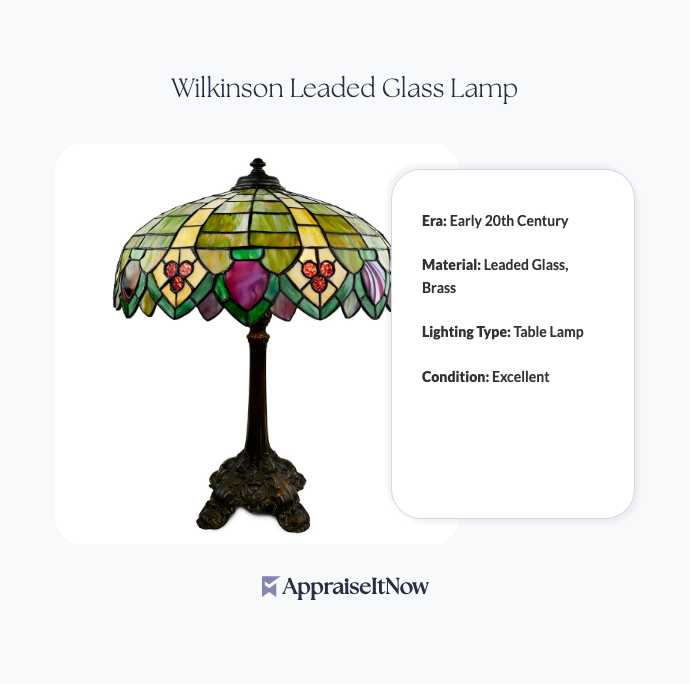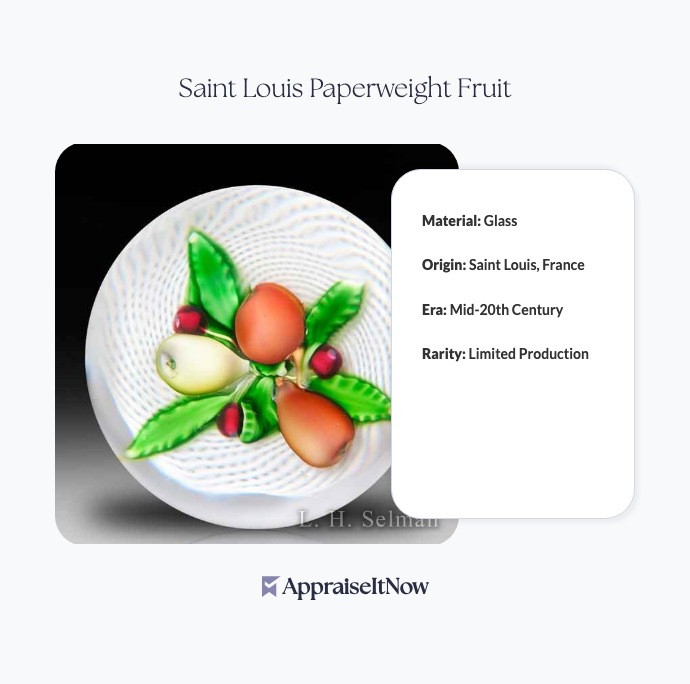<h1>How to Get Your Wilkinson Leaded Glass Lamp Appraised</h1>
<p>The Wilkinson Leaded Glass Lamp represents a pinnacle of art deco craftsmanship, with values ranging from <strong>$3,500 to $5,500</strong> depending on condition, rarity, and provenance. If you're considering selling, insuring, or simply understanding the worth of this early 20th-century treasure, professional appraisal provides the certified documentation and market insights you need. Let's walk through what makes these lamps valuable and how to navigate the appraisal process.</p>
<h2>Understanding Wilkinson Leaded Glass Lamp Value</h2>
<p>The Wilkinson Leaded Glass Lamp emerged from the <strong>Wilkinson Glass Company during the 1920s</strong>, a period when leaded glass lighting reached its artistic zenith. Each lamp showcases <strong>multicolored leaded glass panels</strong> arranged in intricate art deco patterns, mounted on a <strong>brass-finished metal base</strong> with meticulous detail work. This combination of materials, design excellence, and technical craftsmanship creates pieces highly sought by collectors of <a href="/types/antique-furniture">antique furniture</a> and <a href="/types/household-goods">household goods</a> enthusiasts alike.</p>
<p>The rarity of authentic Wilkinson lamps significantly impacts their market position. Unlike mass-produced lighting fixtures, these handcrafted pieces were created in limited quantities, making each example increasingly valuable in today's collectible market. A well-preserved Wilkinson lamp with excellent condition can achieve the upper range of valuations, while pieces showing age or requiring restoration may fall toward the lower estimates.</p>
<div class="callout tip"><p><strong>Collector's Insight</strong></p>
<p>Wilkinson lamps with documented exhibition history or previous high-profile ownership can command premiums of 15-25% above standard market values.</p></div>
<h2>Key Characteristics That Affect Your Lamp's Appraisal</h2>
<p>Several technical and aesthetic factors directly influence what appraisers determine as your lamp's worth. Understanding these elements helps you recognize what makes your piece valuable and how professional evaluators assess authenticity and condition.</p>
<p>The <strong>leaded glass construction</strong> forms the primary value driver. Unlike slag glass or simple stained glass alternatives, true Wilkinson leaded panels feature hand-cut individual glass pieces soldered together with lead cames, creating a labor-intensive manufacturing process that collectors particularly value. When evaluating whether your lamp uses authentic leaded glass or later reproductions, appraisers examine the solder joints, lead line patterns, and glass thickness—details that distinguish genuine art deco originals from 20th-century revivals.</p>
<p>The <strong>brass finish and metalwork</strong> provide secondary but important value indicators. Original patina on brass bases, even with light oxidation, often commands premiums over polished or replated examples. Replacement bases or mismatched hardware can reduce valuations by 20-30%, making originality a critical authentication factor. Professional appraisers specializing in <a href="/types/antique-artwork">antique artwork</a> and decorative arts understand these distinctions and document them thoroughly in certified reports.</p>
<h3>Condition Assessment Elements</h3>
<p>Your Wilkinson lamp's condition grade directly correlates to its market value. Appraisers evaluate several specific aspects:</p>
<ul>
<li><strong>Glass integrity</strong>: Cracked, missing, or replaced panels significantly reduce value</li>
<li><strong>Lead solder quality</strong>: Original joints versus repairs or replacements</li>
<li><strong>Electrical components</strong>: Original wiring versus modern replacements</li>
<li><strong>Base structural integrity</strong>: Warping, rust, or corrosion on brass</li>
<li><strong>Original finish</strong>: Paint or patina preservation versus refinishing</li>
</ul>
<p>A lamp in <strong>excellent condition</strong> with all original components, intact glass panels, and strong brass finish typically commands the full $5,000-$5,500 range. Conversely, a piece requiring glass replacement or electrical restoration might fall to $3,500-$4,000.</p>
<h2>How to Tell If Your Lamp Is Truly Vintage</h2>
<p>A common question collectors ask: "<em>How old does a lamp have to be to be considered vintage?</em>" The consensus among appraisers typically places items from the 1920s-1980s in the vintage category, though art deco pieces from the Wilkinson period (1920s onward) have transcended "vintage" status to become recognized <a href="/types/antiques">antiques</a>. Authentic Wilkinson lamps predate the 100-year mark only recently, yet their artisanal construction and limited production already position them as collectible investments.</p>
<p>"<em>How to tell if a lamp is vintage?</em>" requires examining several authentication markers. Original Wilkinson lamps feature hand-applied construction techniques visible upon close inspection—irregular lead lines, individual solder joints, and period-appropriate electrical components. Modern reproductions often display uniform patterns suggesting machine production, overly pristine finishes, and contemporary wiring designed for modern safety codes.</p>
<p>To authentically date your lamp, inspect the electrical cord and components carefully. Appraisers can often determine production era through cord fabric type, insulation materials, and plug design. Fabric-wrapped cords with early 20th-century construction differ substantially from later PVC insulation, providing reliable dating indicators for professionals conducting vintage lamp appraisals.</p>
<div class="callout note"><p><strong>Authentication Tip</strong></p>
<p>Original Wilkinson glass lamps rarely have maker's marks beyond subtle signatures occasionally found on metal bases or hidden within leaded patterns—absence of obvious branding actually supports authenticity for pieces of this caliber.</p></div>
<h2>The Most Sought-After Vintage Glass and Colors</h2>
<p>When evaluating what makes certain vintage glass particularly valuable, understanding color rarity becomes essential. "<em>What is the most sought after vintage glass?</em>" leads collectors toward rich amber tones, deep cobalt blues, and rare reds—precisely the color palette Wilkinson frequently employed in their finest leaded glass compositions. These colors required specialized glass-making techniques and commanded premium pricing even in the 1920s, making examples surviving to today exceptionally desirable.</p>
<p>Wilkinson's use of <strong>multicolored leaded glass panels</strong> specifically allowed artisans to create complex color harmonies—warm golds transitioning to cool blues, rich jewel tones capturing and diffusing light magnificently. This sophisticated color work distinguishes authentic Wilkinson pieces from simpler single-color or two-tone alternatives that competitors produced more affordably.</p>
<h2>Distinguishing Leaded Glass from Slag Glass</h2>
<p>A frequent confusion among collectors involves slag glass versus authentic leaded construction. "<em>What is slag glass worth?</em>" questions reflect growing interest in this distinct collectible category. Slag glass, created by mixing iron ore waste into molten glass, produces streaked or marbled patterns but requires entirely different manufacturing methods than leaded glass.</p>
<p>Your Wilkinson lamp almost certainly features true leaded glass rather than slag construction. Leaded glass involves individual cut pieces connected through lead channels, while slag glass forms as a unified pour creating natural veining. Appraisers can distinguish between these construction methods through simple visual inspection—leaded patterns show geometric soldering lines, while slag glass displays organic, flowing streaks within single larger panels.</p>
<p>Understanding this distinction matters because slag glass lamps, while valuable collectibles, typically trade at lower price points ($500-$2,000 range) compared to hand-assembled leaded glass examples like your Wilkinson ($3,500-$5,500 range). Professional <a href="/blog/what-do-appraisers-look-for-when-appraising-antique-artwork">artwork appraisals</a> carefully document these technical differences to ensure accurate valuation.</p>
<h2>The Role of Restoration in Appraisal Value</h2>
<p>Restoration dramatically affects your Wilkinson lamp's market position and appraised value. Understanding how much restoration you've had performed—or inherited from previous owners—becomes crucial information for appraisers developing accurate valuations. When considering whether to restore your lamp before appraisal, the answer depends on your timeline and market strategy.</p>
<p>Most collectors and appraisers prefer to evaluate pieces in their current condition without recent restoration work, as this provides clear baseline valuations. If your lamp underwent restoration years ago, professional appraisers account for this through condition adjustment factors and documentation of work performed. However, cosmetic restoration immediately before appraisal can sometimes reduce values rather than increase them, as buyers prefer examining original patina and wear patterns that authenticate age.</p>
<p>The relationship between <a href="/blog/the-impact-of-restoration-and-conservation-on-art-appraisals-balancing-preservation-and-value">restoration and conservation impact on art appraisals</a> directly applies to decorative lighting like your Wilkinson lamp. Reversible restoration (like gentle cleaning) maintains value better than irreversible modifications (like replacing original glass or rewiring with contemporary materials). Professional conservators specializing in <a href="/blog/appraising-fine-glass-and-crystal-valuing-delicate-glassware-and-artistic-creations">fine glass and crystal</a> understand these distinctions and ensure any work enhances rather than diminishes collectibility.</p>
<h2>Market Factors Influencing Current Valuations</h2>
<p>The art deco collectibles market has strengthened substantially over the past decade, with period lighting experiencing particular appreciation. This reflects broader collecting trends toward early 20th-century design, increased decorator interest in authentic historical pieces, and growing recognition of leaded glass artistry among serious collectors.</p>
<p><a href="/blog/the-influence-of-rarity-and-demand-on-the-value-of-personal-property">The influence of rarity and demand</a> on personal property valuations directly impacts your Wilkinson lamp's market position. As surviving examples become scarcer through breakage, loss, or reluctant-to-sell collectors, demand from new collectors intensifies. This fundamental supply-and-demand dynamic supports the current $3,500-$5,500 valuation range and suggests potential future appreciation for well-preserved examples.</p>
<p>Regional factors also influence value. Geographic areas with strong art deco architectural presence and active design communities often support stronger collector markets. Cities like Chicago, Miami, and Los Angeles—known for art deco design heritage—typically see more aggressive pricing for authentic period lighting than regions with less design history focus.</p>
<h2>Preparing Your Lamp for Professional Appraisal</h2>
<p>When you're ready to have your Wilkinson lamp professionally evaluated, proper preparation ensures appraisers can thoroughly examine all relevant details and provide accurate documentation. Start by gently cleaning your lamp to remove surface dust and debris—but avoid aggressive polishing, harsh chemicals, or any restoration work that might alter the piece's current condition baseline.</p>
<p>Document your lamp's current state through high-quality photographs from multiple angles, including close-ups of any markings, signatures, or manufacturing details on both the glass and metal base. These photographs become valuable reference materials during the appraisal process and serve as important documentation for insurance or provenance files. Include photos showing the lamp illuminated, as lighting design represents a crucial artistic element appraisers evaluate when assessing leaded glass pieces.</p>
<p>Gather any available documentation regarding your lamp's history, previous ownership, or acquisition details. Even incomplete provenance information helps appraisers establish context and authenticity. If you have old receipts, auction catalogs, estate documentation, or family records related to the lamp's ownership, compile these materials for the appraiser's review.</p>
<div class="callout tip"><p><strong>Preparation Priority</strong></p>
<p>Never attempt repairs or restoration immediately before appraisal—let professionals assess the piece in its current condition for most accurate valuation and documentation.</p></div>
<h2>Why Professional Appraisal Matters for Wilkinson Lamps</h2>
<p>Obtaining a certified USPAP-compliant appraisal from qualified experts provides multiple essential benefits beyond simple price determination. When you're navigating <a href="/types/personal-property">personal property appraisals</a>, professional documentation becomes invaluable for insurance coverage, estate planning, charitable donations, or sales transactions.</p>
<p>Insurance companies require certified appraisals to establish replacement values for valuable collectibles. Your Wilkinson lamp—potentially worth thousands—deserves the same coverage precision as fine jewelry or artwork. Professional appraisers provide detailed condition documentation, photographic records, and market analysis that insurance companies rely upon when processing claims or adjusting coverage limits.</p>
<p>For estate planning purposes, certified appraisals establish fair market values for asset distribution among heirs or charitable beneficiaries. Tax authorities and probate courts require professional documentation rather than casual estimates. Similarly, if you're considering selling your lamp, appraisal documentation strengthens your negotiating position and helps establish appropriate asking prices aligned with current market conditions.</p>
<h2>Choosing Your Appraiser</h2>
<p>When seeking professional appraisal services, look for credentials specifically relevant to decorative arts and lighting. Qualified appraisers should hold certifications from recognized organizations like the American Society of Appraisers (ASA), International Society of Appraisers (ISA), or American Antique Art Association (AAA). Experience specifically with art deco lighting, leaded glass, and <a href="/blog/appraising-collectibles">collectibles appraisal</a> ensures the evaluator understands the nuanced factors affecting Wilkinson lamp valuations.</p>
<p>AppraiseItNow connects you with credentialed experts across the U.S. who specialize in antique decorative arts and vintage lighting. Our network includes appraisers proficient in examining leaded glass construction, authenticating period pieces, and developing market-supported valuations suitable for any purpose—insurance, sale, estate planning, or personal knowledge. Through our platform, you submit photographs and descriptions securely online, and certified professionals provide detailed appraisals with comprehensive documentation.</p>
<div class="callout note"><p><strong>Key Takeaway</strong></p>
<p>A certified appraisal of your Wilkinson Leaded Glass Lamp provides accurate market documentation, professional authentication, and the detailed records necessary for insurance, estate planning, or sales purposes—transforming your beautiful art deco piece from cherished heirloom into properly valued asset.</p></div>







.avif)







